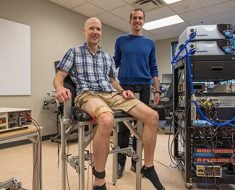
A drug-coated nanoparticle reduces plaque buildup in mouse arteries without causing harmful side effects, Stanford School of Medicine researchers have found.
Atherosclerosis, the accumulation of plaque inside artery walls, can lead to heart attacks and strokes. It’s the world’s No. 1 killer. Available therapies treat risk factors such as high blood pressure and high cholesterol but fail to address the accumulation of diseased cells and inflammation within artery walls.
“This is precision medicine,” said Nicholas Leeper, MD, professor of vascular surgery and cardiovascular medicine. “We used the nanotubes to deliver a payload like a Trojan horse.”
Leeper, who sees patients at Stanford Health Care’s vascular and endovascular care clinic, is a senior author of a paper about the research that was published Jan. 27 in Nature Nanotechnology. The other senior author is Bryan Smith, Ph.D., a former visiting associate professor at the School of Medicine. He is now an associate professor of biomedical engineering at Michigan State University.
Alyssa Flores, a former research fellow who is now a student at the Geisel School of Medicine at Dartmouth College, and Stanford postdoctoral scholars Niloufar Hosseini-Nassab, Ph.D., and Kai-Uwe Jarr, Ph.D., are co-lead authors.
‘Don’t eat me’
Diseased and dying cells in artery plaque give off a “don’t eat me” signal, preventing the immune system’s waste-removal cells, known as macrophages, from engulfing them. The same signal is found on the surface of many types of cancer cells, allowing them to escape detection and multiply. The Leeper lab had previously reported in Nature that certain antibody-based therapies could block this cloaking signal and prevent plaque growth in mice. Unfortunately, this nontargeted approach also resulted in macrophages removing some healthy cells, thus limiting its chance of becoming a new treatment for heart disease.
Smith developed a nanotube to carry a molecule that turns off the “don’t eat me” signal. Unlike the nonspecific antibodies, these nanotubes were taken up by white blood cells (thus the Trojan horse metaphor) that made their way to inflammatory sites such as artery plaque. Once they were inside the plaque, these white blood cells—known at that point as macrophages—”ate up” diseased and dying cells.
“We reactivated their ability to recognize them as a disease, gobble them up and take out the trash,” Leeper said. “But best of all, we didn’t see any significant toxicities this time.”
Reducing plaque
The researchers found that the nanotherapy reduced plaque by 40% in both female and male mice with less advanced plaque, and it reduced the plaque by 20% in male mice with more advanced plaque.
Because the white blood cells that took in the nanotubes went to artery plaque rather than to healthy tissue, Smith said, the nanotherapy avoided side effects such as anemia and organ damage.
“We were able to constrain the uptake into just the cells we want,” he said. “There’s a general rule of treatment: The more targeted you can get, the fewer side effects you have.”
Source: Read Full Article





